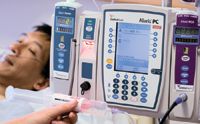Are smart pumps being used intelligently?
The four leading infusion pump manufacturers all report brisk sales of smart pumps, but many users are evading the software dosing safeguards that make pumps smart.

"Smart pumps are selling very well," said Gale White, B. Braun VP, Infusion Systems Division. "The smart pump technology discussion has helped elevate a very mundane piece of equipment. Pumps were a non-sexy technology that has become a must-have for every hospital."
Reality strikes when the first smart pumps start appearing on the floor, White said. Too many institutions deploy smart pumps without first taking the key step of winning over the nurses, pharmacists, and physicians who will actually use the new technology. "People are used to doing things the old way," White said. "You've got to be sure that the nurses who use the pumps are adequately trained. Otherwise, they just disengage the safety features and go back to rate delivery. This software protection isn't a marketing gimmick, it's a patient safety issue."

ISMP is generally credited for coining the term smart pump in 2002. An article in ISMP's newsletter, Medication Safety Alert, described how safety software built into pumps that had just been introduced by Alaris Medical Systems (since acquired by Cardinal Health) and Baxter Healthcare could reduce medication errors.
"Smart" software checks each infusion against predefined dose limits and other clinical parameters. Dosing parameters are part of a drug library that can be customized by each hospital or health system. If a pump user programs a dose that is outside established range limits, the pump either issues an alert (soft limit violation) or shuts down (hard limit violation). Soft limits can usually be overridden by the user. Doses that violate hard limits must be corrected before the pump will function again.

Several industry insiders told Drug Topics that conventional wisdom in the pump industry says that fewer than 25% of smart pumps are consistently used in the smart mode. White said that B. Braun is seeing anywhere from 45% to 75% of its Outlook line of smart pumps used in the smart mode with the built-in DoseGuard system.
One hospital had less than 15% smart use. The compliance problem was nurses who had not been trained on the system before it was introduced. Because they did not understand how automated dose limits could improve patient safety or how to use the system, they bypassed and disabled system safeguards.